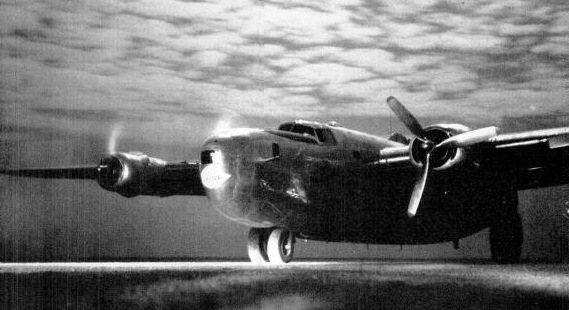


On May 29 the Army's Air Transport Command was 3 years old.
From its initial personnel of six it had matured into a vast and military organization with a personnel of 108,000 officers and men operating regularly over 125,000 miles of airways that girdle the globe.
ATC has long draped mantles of secrecy about its routes and remote bases, carved amazingly from mountains, jungles, deserts and the ice fields of the north.
But last month it decided to lift the curtain on one of its longest, most romantic, most important airways - the 13,000 mile run from Miami to India.
To LIFE's Photographer Tom McAvoy went the extraordinary experience of flying to India and back in 10 days via ATC's Fire Ball Express.
 McAVOY CHATS WITH COPILOT ABOVE SOUTH AMERICA
McAVOY CHATS WITH COPILOT ABOVE SOUTH AMERICA
|
Originally pioneered by the world-circling engineers and pilots of Pan American Airways, the route of the Fire Ball cuts across the Caribbean, down the coast of South America to Natal, across the Atlantic to Accra, across Africa to the Red Sea, thence east to India.
Operating several times weekly, the great transport liners on the Fire Ball carry their precious cargoes to the very foot of the Himalayas, whence ATC's India-China wing lifts them "over the hump" to the forces of General Chennault.
On the pages that follow you fly with Photographer McAvoy over tropical seas and the jungles of equatorial Africa,
over the Nile and the sands of Arabia, over the white frozen poetry of the Taj Mahal.
It was an arduous assignment for McAvoy.
The Fire Ball's crews were relieved daily, but he stayed with the ship.
During 10 days he barely set foot on solid earth, for the Fire Ball's schedule grants it no more than an hour's pause at each base.
As it happened, mechanical ills delayed the plane several hours on four occasions.
Even so McAvoy had no sleep longer than a nap, few meals more substantial than a snack.
Once in a sudden down-draft over Africa, McAvoy was lifted abruptly from his seat to the top of the plane, where the steel frame gashed his scalp, and then tossed painfully onto his shoulder upon the metal floor.
McAvoy left Miami May 5, reached Chabua, India, May 10.
He turned around three hours later and arrived home on May 15.
 The Start
Early on morning of May 5 Photographer McAvoy took a last look at U.S. soil as the Fire Ball circled Miami and soared southeastward on the first lap of its passage to India.
The Start
Early on morning of May 5 Photographer McAvoy took a last look at U.S. soil as the Fire Ball circled Miami and soared southeastward on the first lap of its passage to India.
|
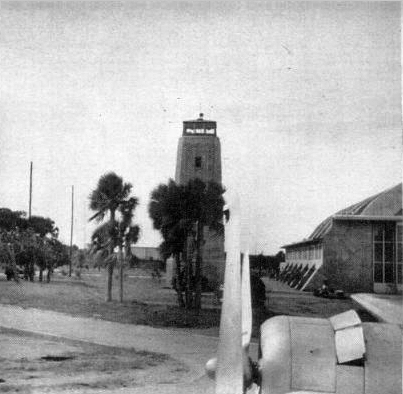 900 Miles
Some five and a half hours later the big ship landed at Borinquen Field, Puerto Rico.
During brief halt here lunch was served to McAvoy and crews, weather reports were studied, fuel tanks refilled.
900 Miles
Some five and a half hours later the big ship landed at Borinquen Field, Puerto Rico.
During brief halt here lunch was served to McAvoy and crews, weather reports were studied, fuel tanks refilled.
|
 1,925 miles
At Atkinson Field, Georgetown, British Guiana, crew which flew Fire Ball on trip from Miami dropped off and a relief crew came aboard.
1,925 miles
At Atkinson Field, Georgetown, British Guiana, crew which flew Fire Ball on trip from Miami dropped off and a relief crew came aboard.
|
 2,600 Miles
In the small hours of May 6 the Fire Ball eased onto the airfield at Belem, Brazil, erstwhile center of a 19th Century rubber industry boom.
The breakfast stopover here lasted 68 minutes.
2,600 Miles
In the small hours of May 6 the Fire Ball eased onto the airfield at Belem, Brazil, erstwhile center of a 19th Century rubber industry boom.
The breakfast stopover here lasted 68 minutes.
|
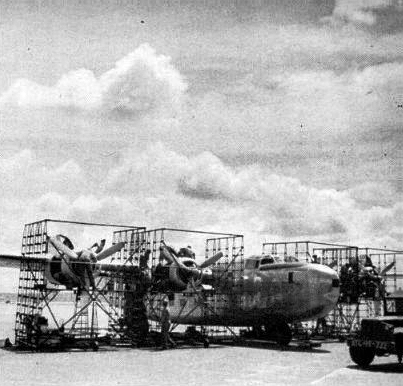 3,570 miles
At Natal, last stop in South America, flight schedule was delayed 12 hours while mechanics repaired propeller governors which had caused trouble during day.
3,570 miles
At Natal, last stop in South America, flight schedule was delayed 12 hours while mechanics repaired propeller governors which had caused trouble during day.
|
 5,020 Miles
A little after noon on May 7 Fire Ball landed on Ascension Island, a rocky dot in mid-Atlantic which breaks the long hop from South America to the African coast.
5,020 Miles
A little after noon on May 7 Fire Ball landed on Ascension Island, a rocky dot in mid-Atlantic which breaks the long hop from South America to the African coast.
|
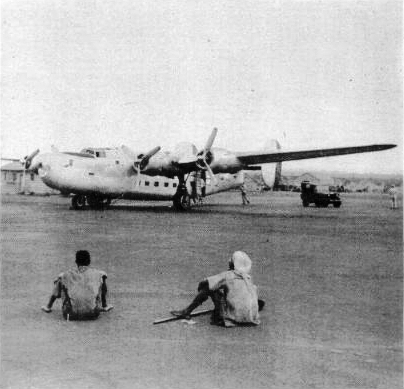 6,395 miles
At Accra on African Gold Coast propeller trouble again delayed the Fire Ball for several hours.
McAvoy made use of pause to shower, sleep.
Flight was resumed early on morning of May 8.
6,395 miles
At Accra on African Gold Coast propeller trouble again delayed the Fire Ball for several hours.
McAvoy made use of pause to shower, sleep.
Flight was resumed early on morning of May 8.
|
 7,295 Miles
Tall black natives with gas cans on heads met Fire Ball at Maiduguri after six-hour flight across mountains, jungle, dry Nigerian plains.
7,295 Miles
Tall black natives with gas cans on heads met Fire Ball at Maiduguri after six-hour flight across mountains, jungle, dry Nigerian plains.
|
 8,595 miles
At Khartoum, the Nile-girdled metropolis of the Anglo-Egyptian Sudan, the plane halted for six hours while mechanics checked motors, tinkered with magnetos and still-troublesome propellers.
8,595 miles
At Khartoum, the Nile-girdled metropolis of the Anglo-Egyptian Sudan, the plane halted for six hours while mechanics checked motors, tinkered with magnetos and still-troublesome propellers.
|
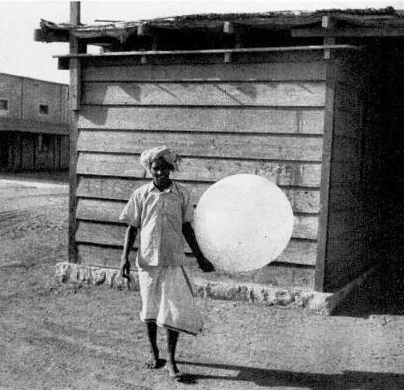 9,495 Miles
As blistering equatorial sun rose May 9, Fire Ball landed at Aden, in southern Arabia and McAvoy shot this picture of a native carrying a meteorological balloon.
9,495 Miles
As blistering equatorial sun rose May 9, Fire Ball landed at Aden, in southern Arabia and McAvoy shot this picture of a native carrying a meteorological balloon.
|
 10,495 miles
At Masirah Island in Arabian Sea Fire Ball was fueled from underground tank.
Heat is so intense ordinary gasoline trucks burst.
This day it was 116° in the shade.
10,495 miles
At Masirah Island in Arabian Sea Fire Ball was fueled from underground tank.
Heat is so intense ordinary gasoline trucks burst.
This day it was 116° in the shade.
|
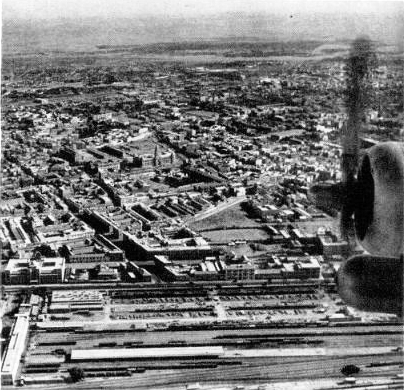 11,145 Miles
Three-hour flight brought Fire Ball to Karachi, the third seaport of India and terminus of Pan American's Cannonball India run.
City is sometimes shrouded by sand storms from the deserts.
11,145 Miles
Three-hour flight brought Fire Ball to Karachi, the third seaport of India and terminus of Pan American's Cannonball India run.
City is sometimes shrouded by sand storms from the deserts.
|
 11,845 miles
At dawn May 10 Fire Ball reached Agra in central India, where McAvoy could, during halt, photograph natives going to work in fields.
11,845 miles
At dawn May 10 Fire Ball reached Agra in central India, where McAvoy could, during halt, photograph natives going to work in fields.
|
 12,245 Miles
Short hop over irrigated farms of the upper Ganges took plane to Gaya, rich with relics and recollections of Buddha.
As a rule ATC planes stop either at Agra or Gaya, but not at both.
12,245 Miles
Short hop over irrigated farms of the upper Ganges took plane to Gaya, rich with relics and recollections of Buddha.
As a rule ATC planes stop either at Agra or Gaya, but not at both.
|
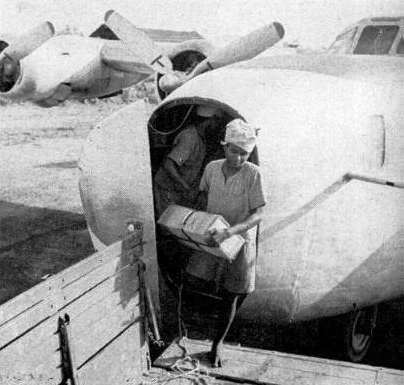 12,970 miles
End of the line was Chabua, at foot of vast Himalaya uplift.
Here trucks backed up to the Fire Ball, unloaded its precious cargo for Chennault's fliers in China.
12,970 miles
End of the line was Chabua, at foot of vast Himalaya uplift.
Here trucks backed up to the Fire Ball, unloaded its precious cargo for Chennault's fliers in China.
|
 CHIEF PILOT AT ASCENSION gets permission for McAvoy to take pictures.
Sign indicates ATC ships double as patrol planes, watch constantly for subs, ships, survivors.
CHIEF PILOT AT ASCENSION gets permission for McAvoy to take pictures.
Sign indicates ATC ships double as patrol planes, watch constantly for subs, ships, survivors.
|

|
THE TAJ MAHAL, beautiful as a cloud in the rays of the rising sun, floats beneath the plane at Agra.
Supreme example of Moslem architecture and deemed by many the lovliest building in the world, the Taj was built between 1632 and 1650 by Shah Jehan as a tomb for his beloved wife.
Domes, minarets and terrace are of pure white marble, inlaid and illuminated with agates, bloodstones and jaspers.
Privileged among men to view it from the air, the young pilots of ATC seldom pass without an enraptured glance at this testament of a prince's love.
|
|

|
THE SUN RISES OVER THE RED SEA, out of Arabia to the east.
Across the dark waters below, the fleets of Eurasia have coursed since days of Nineveh and Tyre: aircraft carriers, clippers, barques and ancient quinqueremes.
For 3,000 years the Red Sea has been the gateway to India.
|
|
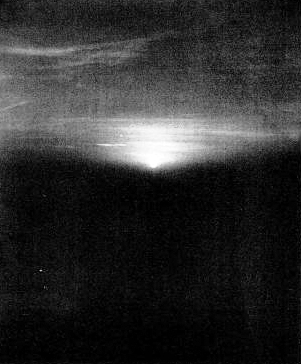
|
THE MOON SETS OVER THE RED SEA. McAvoy took this picture through a starboard window of the plane a moment after he had photographed the sunrise from the port side (left).
Here the Fire Ball, descended from the towering mountains of Eritrea, is nearing the city of Aden.
|
|

|
THE ANCIENT CITY OF ADEN lies dreaming as it has for centuries at the mouth of the Red Sea.
In the days of the Roman Empire it was a major port on the old spice route to India. Now a British colony, Aden has been an important coaling and transshipping station since opening of the Suez Canal. Nestled in the barren crater of an extinct volcano, Aden is one of the hottest and driest cities in the world. Upon it barely half an inch of rain descends from year's end to year's end. Water is brought in from beyond the mountains by a long aqueduct.
|
|

|
"ALONE, ALONE, ALL, ALL ALONE Alone on a wide, wide sea!"
For many a young ATC pilot, these words of The Ancient Mariner have connoted the emotions he felt on surveying the landless void of sky and water that separates Accra and Ascension Island.
Here are the emtiest stretches of the western sea.
Over them roll swiftly-gathering storms.
In them abide schools of ravening sharks.
Aware of their chance of rescue if downed in these wide waters the fliers of ATC breathe thanksgiving when Ascension island finally shows at horizon's rim.
|
|
 THE CONFLUENCE OF THE BLUE NILE AND THE WHITE NILE is unmistakable landmark which guides ATC planes to Khartoum, capital of the Anglo-Eqyptian Sudan, just out of picture to left.
Obvious in this remarkable photograph is the contrast between the darker, sky-mirrored clear Blue Nile and the light muddy White Nile.
Modern Khartoum was laid out by Kitchener who captured the old city from Khalifa Abdullah in 1898.
Its name, in local Arabic dialect, means elephant's trunk - which the promontory at the rivers' junction is supposed to resemble.
THE CONFLUENCE OF THE BLUE NILE AND THE WHITE NILE is unmistakable landmark which guides ATC planes to Khartoum, capital of the Anglo-Eqyptian Sudan, just out of picture to left.
Obvious in this remarkable photograph is the contrast between the darker, sky-mirrored clear Blue Nile and the light muddy White Nile.
Modern Khartoum was laid out by Kitchener who captured the old city from Khalifa Abdullah in 1898.
Its name, in local Arabic dialect, means elephant's trunk - which the promontory at the rivers' junction is supposed to resemble.
|
 ELEPHANT TRACKS dent marshy shores of Lake Chad.
Here, deep in French Equatorial Africa, Theodore Roosevelt once hunted big game.
Here herds of elephants, hippos and wild horses incomputably range the steamy bush.
Shortly before McAvoy took this photograph he sighted a family of hippos disporting in Chad's muddy waters.
The plane buzzed them and they submerged.
Turbid and stagnant, huge Lake Chad is fed by many streams, has no outlet.
For many years now it has been mysteriously drying up.
The maximum depth of its waters is 24 feet.
ELEPHANT TRACKS dent marshy shores of Lake Chad.
Here, deep in French Equatorial Africa, Theodore Roosevelt once hunted big game.
Here herds of elephants, hippos and wild horses incomputably range the steamy bush.
Shortly before McAvoy took this photograph he sighted a family of hippos disporting in Chad's muddy waters.
The plane buzzed them and they submerged.
Turbid and stagnant, huge Lake Chad is fed by many streams, has no outlet.
For many years now it has been mysteriously drying up.
The maximum depth of its waters is 24 feet.
|

|
REMOTE, MIST-MANTLED, AUSTERE, Ascension island rears its serrated ridges of reddish rock from the lonely South Atlantic.
To raise this tiny landfall after the long leap across from Accra or Natal entails consummate navigational skill.
Many a pilot overshoots, must be guided in by radio beam or escort plane.
|
|
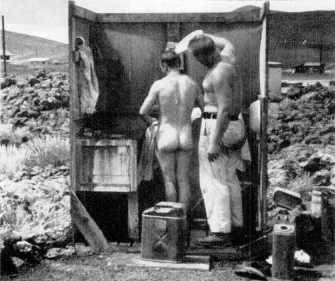 RUGGED BATHING FACILITIES MAKE SPARING USE OF PRECIOUS FRESH WATER
RUGGED BATHING FACILITIES MAKE SPARING USE OF PRECIOUS FRESH WATER
|
|
ASCENSION ISLAND IS
AIRPORT IN THE SEA
|
Elusive as Moby Dick to Captain Ahab, Ascension island is moored midway between the African and South American coasts.
There it rides in watery isolation, a tiny dot of red volcanic rock, seven miles by five, often cloud-hung, barren save for one tree, but blessed by anxious pilots when they see it rise from the sea on the long flight between Natal, 1,450 miles westward, and Accra, 1,375 miles to the east.
The nearest land is St. Helena, 800 miles distant, where Napoleon died in exile.
When Photographer McAvoy landed here he found a splendid air base hacked from the cold lava of a mountainside.
Engineers had first thought it impossible to construct a runway on naked Ascension island.
But they built one in 91 days.
Several thousand American soldiers now dwell where only a few British cable-maintenance men and myriad chattering terns once lived.
All their food must be imported and all their water distilled from the salt sea.
Along the great air route from Miami to Chabua no way station is so remote as Ascension, none more vital than the many winged supply lines of the sky.
|

 THE ISLAND'S ONE AND ONLY TREE (left) is a weather-beaten palm which rattles wind-swept fronds above the Army barracks.
Soldiers call it "Coconut Grove" and under it have placed a "Honeymoon Beach."
Right: tents and barracks house Ascension's soldiers.
At bottom of picture is an outdoor screen for movies.
THE ISLAND'S ONE AND ONLY TREE (left) is a weather-beaten palm which rattles wind-swept fronds above the Army barracks.
Soldiers call it "Coconut Grove" and under it have placed a "Honeymoon Beach."
Right: tents and barracks house Ascension's soldiers.
At bottom of picture is an outdoor screen for movies.
|

LIFE'S COVER: On the cover of this week's LIFE are a few of the men who will make or break the coming invasion of Europe.
They are U.S. infantry - lean, hard, professional infighters, part of the biggest and best Army the U.S. has ever put in the field. Under the command of Lieut. General Omar N. Bradley they will be the ones to prove the fiber of this Army on D-day.


Adapted by Carl W. Weidenburner
from the June 5, 1944 issue of LIFE.
Portions copyright 1944 Time, Inc.
FOR NON-COMMERCIAL HISTORICAL REFERENCE ONLY
TOP OF PAGE
ABOUT THIS PAGE
MORE FIREBALL RXPRESS PHOTOS
MORE CBI FROM LIFE MAGAZINE
CLOSE THIS WINDOW
|




 The Start
Early on morning of May 5 Photographer McAvoy took a last look at U.S. soil as the Fire Ball circled Miami and soared southeastward on the first lap of its passage to India.
The Start
Early on morning of May 5 Photographer McAvoy took a last look at U.S. soil as the Fire Ball circled Miami and soared southeastward on the first lap of its passage to India.
 900 Miles
Some five and a half hours later the big ship landed at Borinquen Field, Puerto Rico.
During brief halt here lunch was served to McAvoy and crews, weather reports were studied, fuel tanks refilled.
900 Miles
Some five and a half hours later the big ship landed at Borinquen Field, Puerto Rico.
During brief halt here lunch was served to McAvoy and crews, weather reports were studied, fuel tanks refilled.
 1,925 miles
At Atkinson Field, Georgetown, British Guiana, crew which flew Fire Ball on trip from Miami dropped off and a relief crew came aboard.
1,925 miles
At Atkinson Field, Georgetown, British Guiana, crew which flew Fire Ball on trip from Miami dropped off and a relief crew came aboard.
 2,600 Miles
In the small hours of May 6 the Fire Ball eased onto the airfield at Belem, Brazil, erstwhile center of a 19th Century rubber industry boom.
The breakfast stopover here lasted 68 minutes.
2,600 Miles
In the small hours of May 6 the Fire Ball eased onto the airfield at Belem, Brazil, erstwhile center of a 19th Century rubber industry boom.
The breakfast stopover here lasted 68 minutes.
 3,570 miles
At Natal, last stop in South America, flight schedule was delayed 12 hours while mechanics repaired propeller governors which had caused trouble during day.
3,570 miles
At Natal, last stop in South America, flight schedule was delayed 12 hours while mechanics repaired propeller governors which had caused trouble during day.
 5,020 Miles
A little after noon on May 7 Fire Ball landed on Ascension Island, a rocky dot in mid-Atlantic which breaks the long hop from South America to the African coast.
5,020 Miles
A little after noon on May 7 Fire Ball landed on Ascension Island, a rocky dot in mid-Atlantic which breaks the long hop from South America to the African coast.
 6,395 miles
At Accra on African Gold Coast propeller trouble again delayed the Fire Ball for several hours.
McAvoy made use of pause to shower, sleep.
Flight was resumed early on morning of May 8.
6,395 miles
At Accra on African Gold Coast propeller trouble again delayed the Fire Ball for several hours.
McAvoy made use of pause to shower, sleep.
Flight was resumed early on morning of May 8.
 7,295 Miles
Tall black natives with gas cans on heads met Fire Ball at Maiduguri after six-hour flight across mountains, jungle, dry Nigerian plains.
7,295 Miles
Tall black natives with gas cans on heads met Fire Ball at Maiduguri after six-hour flight across mountains, jungle, dry Nigerian plains.
 8,595 miles
At Khartoum, the Nile-girdled metropolis of the Anglo-Egyptian Sudan, the plane halted for six hours while mechanics checked motors, tinkered with magnetos and still-troublesome propellers.
8,595 miles
At Khartoum, the Nile-girdled metropolis of the Anglo-Egyptian Sudan, the plane halted for six hours while mechanics checked motors, tinkered with magnetos and still-troublesome propellers.
 9,495 Miles
As blistering equatorial sun rose May 9, Fire Ball landed at Aden, in southern Arabia and McAvoy shot this picture of a native carrying a meteorological balloon.
9,495 Miles
As blistering equatorial sun rose May 9, Fire Ball landed at Aden, in southern Arabia and McAvoy shot this picture of a native carrying a meteorological balloon.
 10,495 miles
At Masirah Island in Arabian Sea Fire Ball was fueled from underground tank.
Heat is so intense ordinary gasoline trucks burst.
This day it was 116° in the shade.
10,495 miles
At Masirah Island in Arabian Sea Fire Ball was fueled from underground tank.
Heat is so intense ordinary gasoline trucks burst.
This day it was 116° in the shade.
 11,145 Miles
Three-hour flight brought Fire Ball to Karachi, the third seaport of India and terminus of Pan American's Cannonball India run.
City is sometimes shrouded by sand storms from the deserts.
11,145 Miles
Three-hour flight brought Fire Ball to Karachi, the third seaport of India and terminus of Pan American's Cannonball India run.
City is sometimes shrouded by sand storms from the deserts.
 11,845 miles
At dawn May 10 Fire Ball reached Agra in central India, where McAvoy could, during halt, photograph natives going to work in fields.
11,845 miles
At dawn May 10 Fire Ball reached Agra in central India, where McAvoy could, during halt, photograph natives going to work in fields.
 12,245 Miles
Short hop over irrigated farms of the upper Ganges took plane to Gaya, rich with relics and recollections of Buddha.
As a rule ATC planes stop either at Agra or Gaya, but not at both.
12,245 Miles
Short hop over irrigated farms of the upper Ganges took plane to Gaya, rich with relics and recollections of Buddha.
As a rule ATC planes stop either at Agra or Gaya, but not at both.
 12,970 miles
End of the line was Chabua, at foot of vast Himalaya uplift.
Here trucks backed up to the Fire Ball, unloaded its precious cargo for Chennault's fliers in China.
12,970 miles
End of the line was Chabua, at foot of vast Himalaya uplift.
Here trucks backed up to the Fire Ball, unloaded its precious cargo for Chennault's fliers in China.
 CHIEF PILOT AT ASCENSION gets permission for McAvoy to take pictures.
Sign indicates ATC ships double as patrol planes, watch constantly for subs, ships, survivors.
CHIEF PILOT AT ASCENSION gets permission for McAvoy to take pictures.
Sign indicates ATC ships double as patrol planes, watch constantly for subs, ships, survivors.





 THE CONFLUENCE OF THE BLUE NILE AND THE WHITE NILE is unmistakable landmark which guides ATC planes to Khartoum, capital of the Anglo-Eqyptian Sudan, just out of picture to left.
Obvious in this remarkable photograph is the contrast between the darker, sky-mirrored clear Blue Nile and the light muddy White Nile.
Modern Khartoum was laid out by Kitchener who captured the old city from Khalifa Abdullah in 1898.
Its name, in local Arabic dialect, means elephant's trunk - which the promontory at the rivers' junction is supposed to resemble.
THE CONFLUENCE OF THE BLUE NILE AND THE WHITE NILE is unmistakable landmark which guides ATC planes to Khartoum, capital of the Anglo-Eqyptian Sudan, just out of picture to left.
Obvious in this remarkable photograph is the contrast between the darker, sky-mirrored clear Blue Nile and the light muddy White Nile.
Modern Khartoum was laid out by Kitchener who captured the old city from Khalifa Abdullah in 1898.
Its name, in local Arabic dialect, means elephant's trunk - which the promontory at the rivers' junction is supposed to resemble.
 ELEPHANT TRACKS dent marshy shores of Lake Chad.
Here, deep in French Equatorial Africa, Theodore Roosevelt once hunted big game.
Here herds of elephants, hippos and wild horses incomputably range the steamy bush.
Shortly before McAvoy took this photograph he sighted a family of hippos disporting in Chad's muddy waters.
The plane buzzed them and they submerged.
Turbid and stagnant, huge Lake Chad is fed by many streams, has no outlet.
For many years now it has been mysteriously drying up.
The maximum depth of its waters is 24 feet.
ELEPHANT TRACKS dent marshy shores of Lake Chad.
Here, deep in French Equatorial Africa, Theodore Roosevelt once hunted big game.
Here herds of elephants, hippos and wild horses incomputably range the steamy bush.
Shortly before McAvoy took this photograph he sighted a family of hippos disporting in Chad's muddy waters.
The plane buzzed them and they submerged.
Turbid and stagnant, huge Lake Chad is fed by many streams, has no outlet.
For many years now it has been mysteriously drying up.
The maximum depth of its waters is 24 feet.


 THE ISLAND'S ONE AND ONLY TREE (left) is a weather-beaten palm which rattles wind-swept fronds above the Army barracks.
Soldiers call it "Coconut Grove" and under it have placed a "Honeymoon Beach."
Right: tents and barracks house Ascension's soldiers.
At bottom of picture is an outdoor screen for movies.
THE ISLAND'S ONE AND ONLY TREE (left) is a weather-beaten palm which rattles wind-swept fronds above the Army barracks.
Soldiers call it "Coconut Grove" and under it have placed a "Honeymoon Beach."
Right: tents and barracks house Ascension's soldiers.
At bottom of picture is an outdoor screen for movies.



